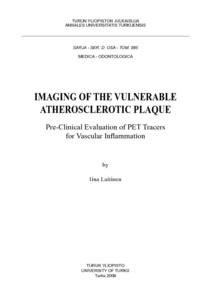Imaging of the Vulnerable Atherosclerotic Plaque. Pre-Clinical Evaluation of PET Tracers for Vascular Inflammation
Laitinen, Iina (2009-12-12)
Imaging of the Vulnerable Atherosclerotic Plaque. Pre-Clinical Evaluation of PET Tracers for Vascular Inflammation
Laitinen, Iina
(12.12.2009)
Turun yliopisto
Julkaisun pysyvä osoite on:
https://urn.fi/URN:ISBN:978-951-29-4149-0
https://urn.fi/URN:ISBN:978-951-29-4149-0
Kuvaus
Siirretty Doriasta
ei tietoa saavutettavuudesta
ei tietoa saavutettavuudesta
Tiivistelmä
Atherosclerosis is a vascular inflammatory disease causing coronary artery disease, myocardial infarct and stroke, the leading causes of death in Finland and in many other countries. The development of atherosclerotic plaques starts already in childhood and is an ongoing process throughout life. Rupture of a plaque and the following occlusion of the vessel is the main reason for myocardial infarct and stroke, but despite extensive research, the prediction of rupture remains a major clinical problem. Inflammation is considered a key factor in the vulnerability of plaques to rupture. Measuring the inflammation in plaques non-invasively is one potential approach for identification of vulnerable plaques.
The aim of this study was to evaluate tracers for positron emission tomography (PET) imaging of vascular inflammation. The studies were performed with a mouse model of atherosclerosis by using ex vivo biodistribution, autoradiography and in vivo PET and computed tomography (CT). Several tracers for inflammation activity were tested and compared with the morphology of the plaques. Inflammation in the atherosclerotic plaques was evaluated as expression of active macrophages.
Systematic analysis revealed that the uptake of 18F-FDG and 11C-choline, tracers for metabolic activity in inflammatory cells, was more prominent in the atherosclerotic plaques than in the surrounding healthy vessel wall. The tracer for αvβ3 integrin, 18Fgalacto- RGD, was also found to have high potential for imaging inflammation in the plaques. While 11C-PK11195, a tracer targeted to receptors in active macrophages, was shown to accumulate in active plaques, the target-to-background ratio was not found to be ideal for in vivo imaging purposes.
In conclusion, tracers for the imaging of inflammation in atherosclerotic plaques can be tested in experimental pre-clinical settings to select potential imaging agents for further clinical testing. 18F-FDG, 18F-galacto-RGD and 11C-choline choline have good properties, and further studies to clarify their applicability for atherosclerosis imaging in humans are warranted.
The aim of this study was to evaluate tracers for positron emission tomography (PET) imaging of vascular inflammation. The studies were performed with a mouse model of atherosclerosis by using ex vivo biodistribution, autoradiography and in vivo PET and computed tomography (CT). Several tracers for inflammation activity were tested and compared with the morphology of the plaques. Inflammation in the atherosclerotic plaques was evaluated as expression of active macrophages.
Systematic analysis revealed that the uptake of 18F-FDG and 11C-choline, tracers for metabolic activity in inflammatory cells, was more prominent in the atherosclerotic plaques than in the surrounding healthy vessel wall. The tracer for αvβ3 integrin, 18Fgalacto- RGD, was also found to have high potential for imaging inflammation in the plaques. While 11C-PK11195, a tracer targeted to receptors in active macrophages, was shown to accumulate in active plaques, the target-to-background ratio was not found to be ideal for in vivo imaging purposes.
In conclusion, tracers for the imaging of inflammation in atherosclerotic plaques can be tested in experimental pre-clinical settings to select potential imaging agents for further clinical testing. 18F-FDG, 18F-galacto-RGD and 11C-choline choline have good properties, and further studies to clarify their applicability for atherosclerosis imaging in humans are warranted.
Kokoelmat
- Väitöskirjat [2963]
